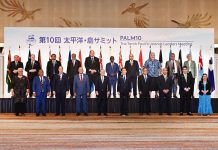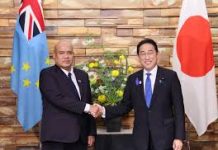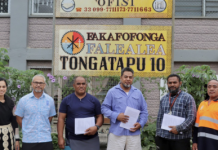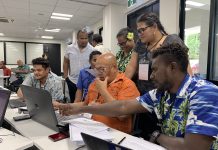Climate envoy for the Marshall Islands says financing must be prioritised to protect the world’s most vulnerable countries
The Marshall Islands may be a small and remote nation but it has become one of the most prominent advocates for climate action on the UN stage.
Its climate envoy Tina Stege spoke to climate correspondent Attracta Mooney last week about the finance gap, the importance of having a seat at the table in global negotiations and the outlook for the UN COP29 summit this year.
She started by addressing questions about the controversy that hung over the final agreement at COP28 gavelled by the UAE president in December without the presence of the Alliance of Small Island States in the room.
Tina Stege: We had been called in overnight and the night before to look at the [draft] text and then received the final text that morning, just a few hours before this decision ultimately got gavelled. I was one of many who were reading the decision text while making my way to the venue at the crack of dawn, trying to get through everything to understand if it was something that we could live with.
Reading through it I definitely saw that there were really good elements that we had fought hard for, but other things that were a complete surprise and very worrisome. Knowing that, [we needed] to consult and talk to other members of the Alliance of Small Island States (Aosis) to understand where everybody sat and whether we could as a group accept that decision.
We got to the venue early and we all went into a room with my colleagues and we had a consultation and a discussion, and it took time, because many of us were quite unhappy with those loopholes that we saw in the text that we felt really weakened it.
We finally came to a decision and made our way to the plenary, and many of us actually had trouble getting in. The security was saying that it was full … it was just very confusing. And then when those of us who could get in did get in, we walked in to everyone standing and cheering and applauding.
I quickly understood that what was happening was it had been gavelled, literally as I was walking to my seat with my minister [of natural resources for the Marshall Islands]. I was just in shock.
[In her statement, Anna Rasmussen, chief negotiator for Aosis] very clearly reflected that state that we all were in when we walked into that room, which is complete shock that this had gone forward without us.
Progress was made [in the final text, but] it was incremental. And for us, that’s frustrating because, you know, being on the front lines, we know viscerally and from our lived experience that incremental progress is not going to save the Marshall Islands.
I think we were clear in [the statements from the chair of Aosis and the minister] about the very difficult place that we felt we were in. We accepted the decision because it had really good elements and the historic element of actually identifying fossil fuels as the root of the problem and the need to transition away — all of those things were positive. But also expressing that it’s just not enough, based on the realities that we live on the ground and that people around the world are experiencing.
Attracta Mooney: When you had come out of your Aosis meeting, what had you agreed to?
TS: Well, as the chair said, she delivered the statement that we were going to deliver. She demanded the floor because it had to be said immediately.
AM: At the time there was some briefing going around that it was a strategic decision from the small islands not to be in the room because it wasn’t an ideal agreement for you.
TS: Yeah, I heard that rumour when we came out of the plenary. It makes no sense at all to me that somehow there’s this idea that we’re there playing games. I mean, that’s the last thing that we come to COP to do. We put all our heart and soul into those negotiations, and we take it so seriously because it is about survival for us.
We consult and we discuss and we make sure that we’re together as a group when we make a decision. To me that thinking supposes that we haven’t been involved every step of the way, that somehow we’re resorting to a game or a strategy. That final language reflects all of the work that we do throughout the year. The fact that the ultimate compromise [where the agreement used the phase “transition away from” instead of the more controversial “phase out of fossil fuels”] actually reflected language that came out of the Pacific is because we’ve been there every step of the way. We know exactly what we can live with.
The fact that you have transitioned away from fossil fuels and economy wide NDCs (Nationally Determined Contributions), and as many references to 1.5 [degrees, the maximum rise in temperatures above pre-industrial levels that small islands have called for] and the science… reflect the hard work of the islands. Those are things that we fought tooth and nail for.
We can, at the same time, shine a light on the fact that it’s absolutely not enough.
When we’re in there with that many countries it is a really tough and frustrating and challenging process that leaves us unhappy and upset almost every time. But at exactly the same time, this really strong commitment to how essential our input is and how we have to be there, to make sure that those commitments are reflected.
AM: Is there something that you can take from this for future COPs? Because the plenary did start late, so you were late to an already late plenary
TS: You don’t think plenaries have started far later? I mean, there are plenaries that start hours [later] because it’s clear that not everyone is on board. It’s a very common practice that, [if] a group is still not there, then they just keep pushing it back. Yes, we were a bit late, but not that late. And [we had] no idea that somehow they would just start without us, because that hasn’t been our experience.
AM: The other thing [Spain’s deputy prime minister and co-lead of the EU delegation] Teresa Ribera talked about to me was that it was an agreement that was really delicate, and that if one person pulled a thread on it, it would just unravel. Do you think it was that?
TS: I do. I think there was an understanding, in our group as well, that it was. So it was a delicate balance.
AM: Overall, what did you think about COP28?
TS: I think it was historic but not necessarily transformational, which is what ultimately the Marshall Islands needs it to be.
I do think there is this idea that somehow the COPs will fix this problem. COPs are an essential tool to drive forward progress and to provide solutions, but what’s most important is the actions that countries take at home, and how they actually implement many of the commitments.
AM: One of the things that wasn’t properly addressed in the COP28 agreement was around finance. Is that a priority for you at COP29?
TS: Finance is absolutely a priority for COP29. I mean, that’s partly because of the biggest topic on the table, which is the new collective quantified goal [on climate finance], which countries have been discussing already in workshops and various fora to lead up to a decision that will be taken at COP29. The key to delivery for all of these commitments that we have agreed to is the finance that will unlock that action.
Those are the things that we need to address in a much more clear way: more specifics and to really get into providing the solutions because it’s not working for developing countries and, in particular, it’s not working for Small Island Developing States (Sids).
Not just those systems that have been set up within the universe of the [United Nations Framework Convention on Climate Change] UNFCCC, so funds like the Green Climate Fund, where there’s tonnes of accessibility issues for Sids … we now have the new loss and damage fund. There’s still quite a bit of work to figure out how to distribute that properly, this year.
It’s also that we have financial architecture more broadly that’s not fit for purpose. And there’s been a lot of discussion on this, by Small Island Developing States, particularly through Barbados’s Bridgetown agenda, with solutions coming from Sids. But other countries in the developing world have been very vocal on this, particularly as a result of the debt crisis that so many countries are experiencing and that has been exacerbated by climate change.
[The question for these countries is]: is transitioning to a green economy just going to further mire us in debt, or is it going to help us address our sustainable development goals? The answer to that is really dependent on the finance and how it’s delivered. Hopefully at COP29 we can help steer that conversation and guide it in a way that reflects the needs of the Marshall Islands and other small island developing states.
AM: For many countries, especially outside the industrial world, they have huge levels of debt, which have only increased since the pandemic, and not the same access — and certainly not at the same rates as the industrial world has — to finance. We’ve got talk of reform of MDBs (multilateral development banks). Do you think that goes far enough?
TS: I don’t think anything so far has gone far enough, but that’s why we’re pushing as much as we can. I do think we have to think about how things work again.
And I’m trying to [look at] how what we do inside the UNFCCC process coordinates, integrates [and] complements the broader conversation with the MDBs and other financial institutions, where, to a large extent, countries like the Marshall Islands don’t have the same ability to access and influence because we’re not sitting on the boards of those banks. We’re not at the table in the same way. [That is] an essential problem with the existing financial architecture, that is currently fuelling inequity rather than addressing inequity.
I’m not sure how it is addressed without more commitment and flexibility on the part of the developed world to open up and bring in the most vulnerable. There are different proposed solutions out there.
The discussions to me are just still quite slow, and there seems to be quite a divide in understanding how well those are going. Looking at it at a very high level, there’s a sense from the developed side that [climate is] now at the heart of what the banks are going to do. And that is a huge step forward. But from the developing side, it’s still not necessarily the step forward that addresses our bread and butter problems. The debt crisis is still very much unfolding there. There haven’t been the commitments needed to ensure that committing to climate action doesn’t just mire you further in debt. So we’re definitely not there yet.
To the extent that we can hopefully push and signal, within the UNFCCC process on what is necessary, because it is a space where countries like the Marshall Islands and the most vulnerable have a voice, then that’s what we need to do this year.
If you look back last year at the discussions around setting up the loss and damage fund, a lot of the difficulties that we experienced [with] those MDBs and financial institutions, those were aired within that discussion around loss and damage finance — how we need new financial systems to work for us and what would be required.
For example, the focus around programmatic funding for climate initiatives, rather than project by project, was something that the Pacific in particular raised very strongly and I think is now reflected in the decision text from COP28.
AM: The loss and damage fund got signed off at COP28 and had some operational cash put into it, but it’s not been financed really. What would you like to see over the course of the next year with the fund?
TS: So there’s basically seed capital. It needs to be sustainably capitalised. That goes back to delivery of finance, the modalities, the systems: how are we actually going to create sustainable flows of finance for that fund and the other funds as well? I think, as the board [for the loss and damage fund] is constituted, that these are some of the issues they’ll be looking at.
AM: The Marshall Islands has set out an adaptation plan on how you adapt for climate change. [Minister of natural resources] John Silk described it as not an adaptation plan, but a survival plan, which is a scary, very forthright way of looking at it. Can you tell me what’s in the plan and why you need it?
TS: The plan sets out what we call adaptation pathways, looking in a very clear-eyed way at what we have to adapt to in different timeframes. To begin with we’re looking at, in the nearest term, nature-based solutions and shoring up our coastlines. But very quickly, it identifies that sea level rise in particular is something that [we need to focus] on.
Very quickly we start to have tipping points beyond which it’s very difficult to adapt to, and it’s more in the medium term we consider what we call transformational adaptation — the idea of needing to not just build up buildings, but potentially raise land. The real difficulty for us in that scenario is having to look for the best places that can be raised — those places that are high enough or maybe just a bit higher than other places. And in the Marshalls, the reason that conversation is so difficult is because all land is not just individual property, it’s communal property, and it’s very much linked to identity.
So the idea of having to choose one or two or three places over certain other islands is just very difficult for us. But that’s what the NAP (National Adaptation Plan) says. It says that ultimately we’ll be needing to do that and consolidate populations in particular places, and it provides a road map for doing that.
That’s going to have to be an ongoing conversation. And it will require tens of billions of dollars, even if we’re just looking at identifying a few atolls and islands, to consolidate populations on, the numbers are still quite staggering. I guess that’s the other piece of this — trying to really look to how the financial architecture and assistance from development partners can help us achieve what is set out in the NAP.
AM: To be clear, whatever happens you are expecting that you will probably have to move people from some of their home islands or atolls to a different place. Is that right?
TS: Ultimately we will. Well, it’ll still be up to the people, we can’t force [them to move]. The one clear faultline that runs through every consultation that we did with people at home is that nobody wants to move. We don’t want to leave the Marshall Islands, so when we’re talking about having people move, we’re talking about internal migration.
AM: What does the Marshall Islands look like 10 or 20 years from now?
TS: Climate change is accelerating changes that have already been happening, where many of our people have been moving to urban centres. What we need to do is identify the best places that will be most resilient and can support more consolidated populations.
We haven’t identified those places as yet. I would say one of the things that makes the Marshall Islands the most resilient is how strong our communities are, and the ties we have to each other, how strong family ties are. That’s really been foundational for us in the ways that we’ve managed to respond to and survive other crises, whether it was the nuclear testing that has happened in our country [from 1946 to 1958 that forced] movement and exile of different communities, or even just the difficulties of the world wars, particularly World War Two, when it came through the islands. We have been able to maintain a very strong culture and community despite all of those crises and challenges.
The key to that is making sure that it’s not about forcing people to do things, it’s about having an ongoing conversation with people about how best to safeguard their families as the sea rises or as life becomes untenable due to drought in islands or atolls. That is going to be the very difficult and ongoing conversation we’re going to be having in the next, not just a year or five years, but ten, 15 years.
AM: You mentioned it’ll be tens of billions [of dollars]. I think I saw that the estimate is up to $35bn that you’ll need for the adaptation plan, which is an awful lot of money. That’s $800,000 per person or something. Do you think you can get that level of financial support from the international community?
TS: Certainly not at the moment. That’s why we have so much work to do to address the fact that financial flows aren’t supporting climate action in the most vulnerable countries. Not at the scale that’s needed, by any shape of the imagination.
I do think that, well, you put it this way, that’s $800,000 per person. You can value it that way [but] you can also value it in terms of: what is the value of a country, and of the culture of a community, what we bring to the world. What do we offer? What is our voice worth? I think it’s incalculable, actually. Imagine what is lost if a country is lost … if there’s one flag [fewer] at the United Nations, what is the world going to be? Is it going to be a world of, you know, 20 flags? And that is an immeasurable loss. I don’t think you can calculate that loss for our planet and for our global community.
I guess we’re the front of the front lines; what happens to us is kind of a reflection of what can happen to so many others. So I think the value and the finance that’s put into making sure that countries like the Marshall Islands continue to exist, to contribute… it can’t be calculated.
AM: There’s also tension at the moment about where the money comes from to help countries adapt, and to finance green transitions. You see the traditional Western industrialised nations wanting to continue to do that, but also China forging strong relationships in many parts of the world around climate finance. Would the Marshall Islands be open to taking cash from China?
TS: I think we need to look at all sources, but what’s really important for any of those sources is the transparency and accountability. For our own purposes, domestically, we need to know not just where the money is coming from, but how it will be used. I think it’s very clear that it’s only with accountability and transparency that you really have action that in fact supports community, rather than potentially just individuals, [and] that you don’t have the corruption that can undercut meaningful, climate action.
AM: Back to COP29, we had the president of Azerbaijan Ilham Aliyev in January announce an all male advisory committee. They’ve since appointed some women. But only about a third of the people involved in climate negotiations are women. Do you think women are under-represented in COP?
TS: I think Teresa Ribera had the best line on this, I don’t know if you saw her tweet. She said ‘no woman to host… no quorum…. no COP’. Because there are so many women at all levels throughout the process, who not just contribute, but without whom the process would not reflect at all what action is actually needed.
We all know that women are disproportionately affected by climate change, and what I say for the Marshall Islands goes for women as well. Those who are disproportionately affected by the crisis have the most to contribute to solving the crisis. It just makes logical sense.
As a woman in this process, I know that it only strengthens the process to ensure that women’s voices are at the heart. Not tokens, not just added to the committee, but actually at the heart of the decisions that the committee will be making.
AM: There is criticism that the COPs don’t achieve much or enough. What is your response to that?
TS: They don’t achieve enough, but at the same time they’re absolutely essential. Without [the Paris agreement], where would we be? We wouldn’t be in a situation where, in fact, we’ve made enormous strides. There is a revolution happening in terms of renewables, and electric vehicles. The question is whether that revolution will include the most vulnerable. Will it benefit those who need it most? And that’s why we’re in there fighting to ensure that we’re not left behind.
That is the ultimate question, and one that we ask ourselves every time, but we go back [to the COPs] because every time we say, well, if we’re not there, they clearly won’t include us. It’s essential that we’re part of it.
SOURCE: THE FINANCIAL TIMES/PACNEWS


















